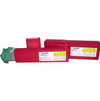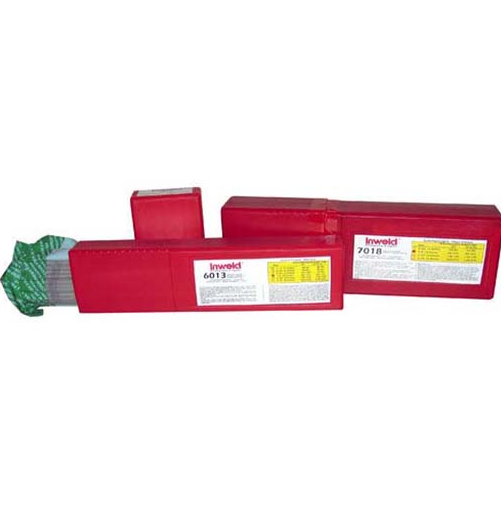

What Are Stick Electrodes?
Welding electrodes are metal wires with baked on chemical coatings. The rod is used to sustain the welding arc and to provide the filler metal required for the joint to be welded. The coating protects the metal from damage, stabilizes the arc, and improves the weld. The diameter of the wire, less the coating, determines the size of the welding rod. This is expressed in fractions of an inch such as 3/32", 1/8", or 5/32." The smaller the diameter means it requires less current and it deposits a smaller amount of filler metal.
Inweld Low Hydrogen Iron Powder E7018 Covered Electrode, 3/32 Inch dia.
Features
- For welding carbon steel, free-machining steel, high tensile steel and low alloy steel
- Special low-hydrogen iron powder coating produces a quiet steady arc, low spatter and medium arc penetration
- High deposition efficiency
- X-ray quality weld deposits with a finely rippled smooth bead appearance and easy slag removal
- Excellent charpy impact values at sub-zero temperatures (65 ft-lb at -20 deg F)
NO hay especificaciones disponibles
What Are Stick Electrodes?
Welding electrodes are metal wires with baked on chemical coatings. The rod is used to sustain the welding arc and to provide the filler metal required for the joint to be welded. The coating protects the metal from damage, stabilizes the arc, and improves the weld. The diameter of the wire, less the coating, determines the size of the welding rod. This is expressed in fractions of an inch such as 3/32", 1/8", or 5/32." The smaller the diameter means it requires less current and it deposits a smaller amount of filler metal.
Inweld Low Hydrogen Iron Powder E7018 Covered Electrode, 3/32 Inch dia.
Features
- For welding carbon steel, free-machining steel, high tensile steel and low alloy steel
- Special low-hydrogen iron powder coating produces a quiet steady arc, low spatter and medium arc penetration
- High deposition efficiency
- X-ray quality weld deposits with a finely rippled smooth bead appearance and easy slag removal
- Excellent charpy impact values at sub-zero temperatures (65 ft-lb at -20 deg F)





